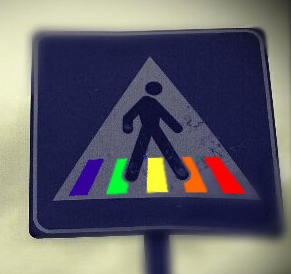The article, Color Walking, by Phia Bennin and Brendan McMullan focuses on an interesting experiment that illuminates the world of color and how people see it, or more so how they do not see it. Color is a part of our daily lives and if we are not careful, we can become numb to it. Teacher William Burroughs created color walking. Burroughs first introduced color walking to his student as a way to inspire them (Bennin and McMullan, lines 3-4). This simple activity has ended up inspiring the authors of this article and many others by opening their eyes to the world of color.
Color walking is simple: walk outside, pick a color, and follow that color by allowing your eyes to bounce from object to object (Bennin and McMullan, lines 5-7). On their advice on how to color walk, the authors note, “If you get lost, pick another color. If you get really lost, you’re on the right track” (Bennin and McMullan, line 22). In the article, readers follow the authors around the city of Manhattan as they feast their eyes upon the wonders of color: a blue scarf, blue at the basketball courts, a purple shirt, and hues of pink. The article provides photos and a timeline of their afternoon spent color walking (a screenshot of this is presented below). At the end of the experiment, the vividness and attention to color stayed in the minds of the authors, “We walked away seeing a world brimming over with colors” (Bennin and McMullan, lines 15-16).
At the end of the article, advice is given on how readers can do their own color walk. Some things to avoid are stopping to run errands, or getting distracted with other things, such as a cell phone. Color walks are about focusing all attention on the world around you. When first choosing which color to follow, pick one that makes you excited. Maybe pick your favorite color, or maybe choose one that happens to catch your eye as you step outside (Bennin and McMullan, lines 19-21). Flexibility is also a major key to color walking; being able to change colors and not just limit your eyes to one. Color walks should be uninterrupted periods of time when all different colors in the built environment jump out at you; the authors call this “eye time”.
Overall, color walking is an experiment that everyone could learn a lot from. It is something that is not practiced by many, but it can benefit our minds and the way we see the world. Color is untouchable and sometimes it is just the way our eyes perceive certain things such as the color of a polar bear’s fur or the color of the sky. Although color is intangible, it affects our daily lives and can change the way we feel. Color walking is a reminder on how color is everywhere all the time. Like McMullan and Bennin say, taking just one hour dedicated to eye time opened their eyes to the world around them and after doing so the colors of their surroundings were imprinted in their brains.
Work Cited
McMullan, Phia Bennin / Brendan. “Color Walking.” Radiolab, June 29, 2012. http://www.radiolab.org/story/214709-color-walk/?utm_source=sharedUrl&utm_medium=metatag&utm_campaign=sharedUrl.

